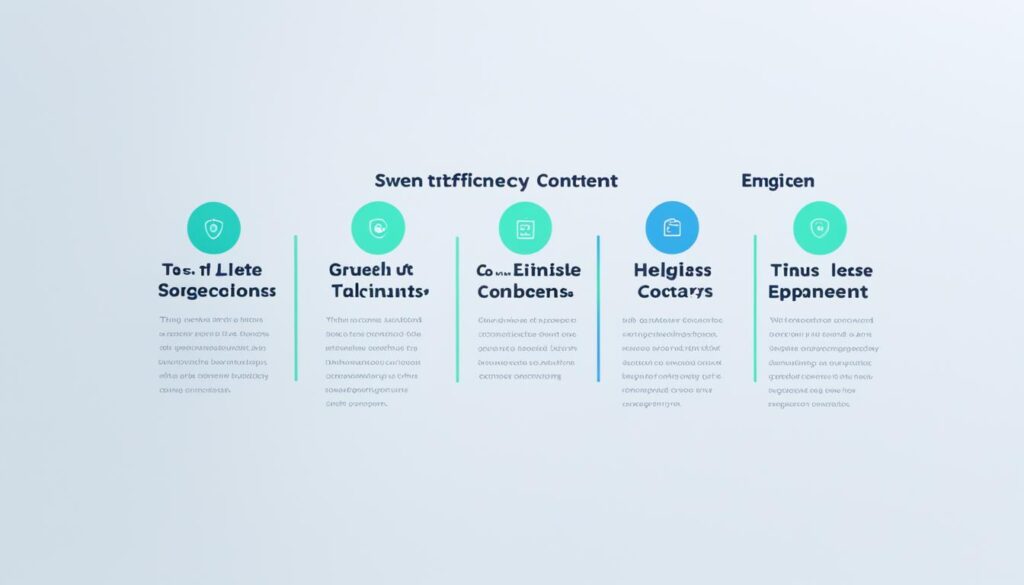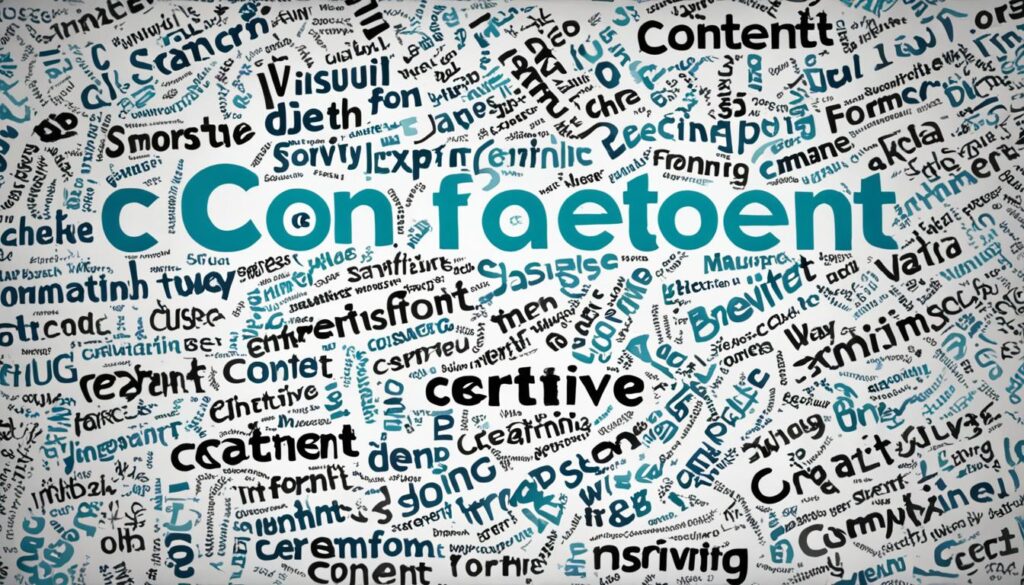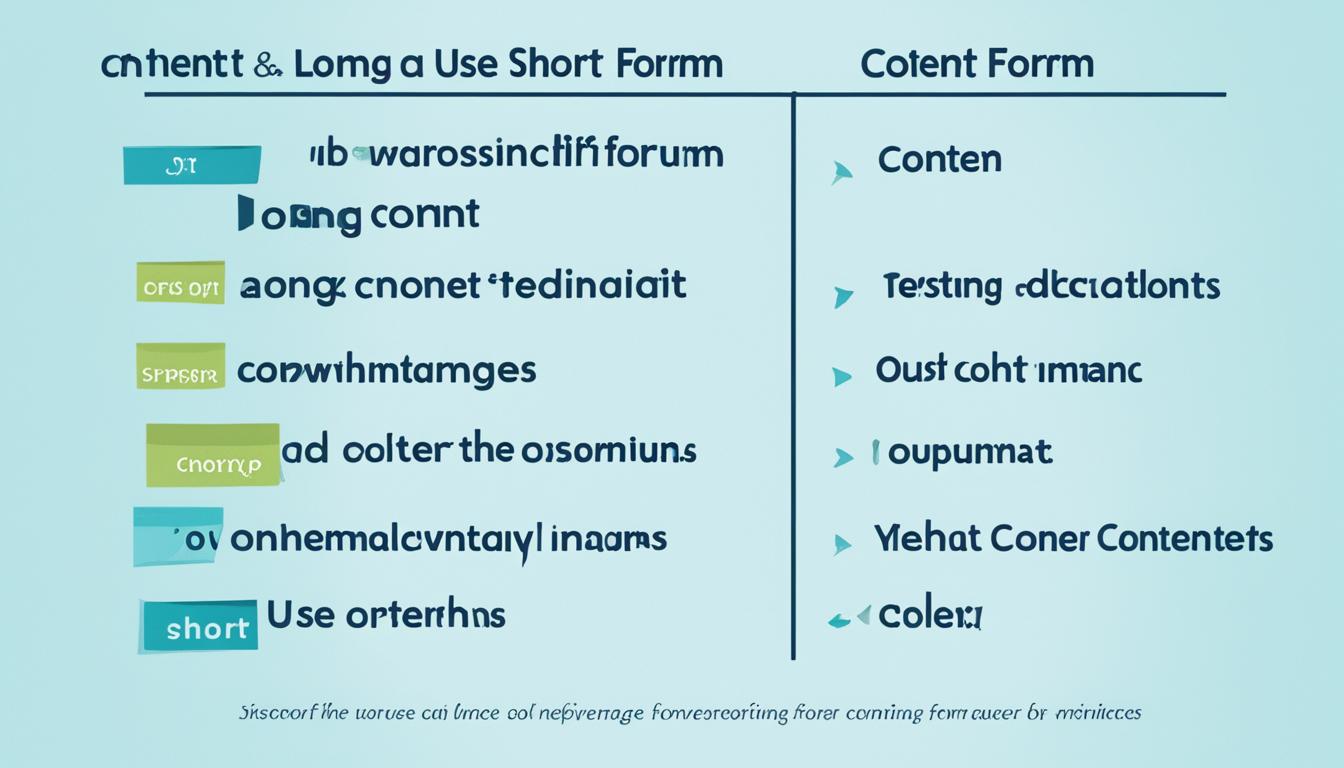When it comes to content marketing, the length of your content matters. Long-form and short-form content each have their own unique advantages and disadvantages. Understanding when and how to use these different content types is crucial for engaging and educating your audience effectively.
In this article, we will explore the pros and cons of long-form and short-form content, providing you with insights to refine your content marketing strategy for maximum impact.
Key Takeaways
- Long-form and short-form content serve different purposes in content marketing.
- Short-form content is concise, easy to consume, and ideal for capturing the attention of busy readers.
- Short-form content includes blog posts, social media posts, infographics, emails, and more.
- Advantages of short-form content include its shareability, quick conversions, and faster production time.
- Disadvantages of short-form content include potential limitations in authority, SEO, and the risk of low-quality content overflow.
- Long-form content provides detailed information, establishes authority, and ranks better in search engines.
- Long-form content includes in-depth blog posts, evergreen pages, guides, whitepapers, and webinars.
- A well-rounded content marketing strategy incorporates both long-form and short-form content.
What is Short-Form Content?
Short-form content, also known as snackable content, is a concise and easily consumable type of content that is designed to deliver information quickly. It is typically under 1,200 words in length, although the exact word count may vary depending on the context and target audience. Short-form content comes in various formats, including:
- Blog posts
- Social media posts
- Infographics
- Emails
Short-form content caters to the needs of busy readers who prefer quick and digestible information. Its brevity allows for maximum impact in a short amount of time and makes it highly shareable on social media platforms, enabling wider reach and engagement.

Types of Short-Form Content
Let’s take a closer look at some examples of short-form content:
- Blog posts: Short and informative articles that provide focused insights on specific topics.
- Social media posts: Brief updates or snippets of information shared on platforms like Facebook, Twitter, and Instagram.
- Infographics: Visual representations of data or concepts that present information in a visually engaging and easily digestible format.
- Emails: Concise messages or newsletters sent to subscribers with the aim of delivering valuable content or promotions.
These are just a few examples of short-form content, but the possibilities are endless. The key is to adapt your content to the preferences of your target audience and deliver valuable information in a concise and engaging manner.
Advantages of Short-Form Content
Short-form content offers several advantages. It is easy to consume content and appeals to audiences with short attention spans. With the rise of social media platforms and busy lifestyles, people are constantly looking for quick and engaging information. Short-form content can be consumed on the go, allowing users to get valuable information without investing too much time.
One of the prominent trends in short-form content is the growing demand for short-form videos. Platforms like TikTok and Instagram Reels have popularized the concept of snackable content, capturing the attention of millions of users worldwide. Short-form videos, with their engaging visuals and concise format, have become highly shareable and effectively communicate messages in a short span of time.
In addition, short-form content is designed for quick conversions. It caters to visitors who are looking for immediate solutions or answers. By providing concise and actionable information, short-form content guides users along the conversion funnel, leading to faster conversions and achieving desired objectives efficiently.
Another advantage of short-form content is the faster production time it allows. Compared to long-form content, creating short-form content requires fewer resources and can be produced at a higher volume. This enables businesses to maintain consistent content output, ensuring regular engagement with their audience.
Short-form content is like a mini boost of information that quickly engages and provides value to the audience. It is perfect for capturing attention, driving conversions, and keeping up with the fast-paced digital landscape.
To illustrate the benefits of short-form content, here’s a visual representation of the advantages:
| Advantages of Short-Form Content | |
|---|---|
| Easy to consume content | Appeals to short attention spans |
| Growing demand for short-form videos | Highly shareable and engaging |
| Quick conversions | Immediate solutions for users |
| Faster production time | Allows for higher content volume |

Disadvantages of Short-Form Content
While short-form content has its benefits, it’s important to be aware of the potential disadvantages associated with this content format.
Less Authoritative
Short-form content may be less authoritative compared to long-form content. Due to its concise nature, short-form content may not provide as much in-depth information as longer pieces. This can impact the perceived credibility and trustworthiness of the content.
SEO Limitations
From an SEO perspective, short-form content may have limitations. It may be more challenging to earn backlinks and establish connections to relevant content when the available space for linking is limited. This can impact the overall visibility and search engine rankings of the content.
Overflow of Low-Quality Content
The ease and speed of producing short-form content can sometimes lead to an overflow of low-quality content. With a lower barrier to entry, there is a risk of subpar content flooding the digital landscape. This can make it harder for high-quality short-form content to stand out and capture the attention of the audience.
| Disadvantages of Short-Form Content | Description |
|---|---|
| Less Authoritative | Short-form content may lack in-depth information, impacting its authority. |
| SEO Limitations | Short-form content may have limitations in earning backlinks and linking to relevant content. |
| Overflow of Low-Quality Content | Short-form content production speed can lead to an overflow of low-quality content, making it harder to stand out. |

“Less Authoritative, SEO Limitations, Overflow of Low-Quality Content”
Understanding the potential disadvantages of short-form content allows content creators to make informed decisions about their content strategy. While short-form content may have its drawbacks, it can still be a valuable tool when used strategically and in combination with other content formats.
What is Long-Form Content?
Long-form content is a valuable format that provides comprehensive and in-depth information on a specific topic. Unlike shorter pieces, long-form content typically exceeds 1,200 words and allows for a thorough exploration of the subject. This type of content is designed to educate and inform the audience, offering a deep dive into a particular subject matter.
Examples of long-form content include:
- In-depth blog posts
- Evergreen pages
- Guides
- White papers
- Webinars
Long-form content requires substantial research and resources to create, but the effort pays off in establishing your brand as an authoritative source of information. By offering detailed insights, analysis, and practical guidance, long-form content can engage and captivate your audience, encouraging them to spend more time on your website and positioning your brand as a thought leader in the industry.

Implementing long-form content as part of your content marketing strategy can yield significant benefits, such as:
- Providing valuable information, addressing your audience’s pain points, and building trust
- Ranking higher in search engines due to the comprehensive nature of the content
- Generating organic backlinks and improving your website’s SEO performance
- Creating evergreen resources that continue to attract traffic over time
Long-form content allows you to dive deeply into a subject, ensuring that your audience receives all the necessary information and resources. By offering comprehensive insights and sharing your expertise, you establish your brand’s credibility, engage your audience, and foster long-term relationships with your readers.
Next, let’s explore the advantages and disadvantages of long-form content to gain a better understanding of its role in your content marketing strategy.
Conclusion
Long-form and short-form content both play crucial roles in an effective content marketing strategy. Short-form content is perfect for capturing the attention of audiences with short attention spans. It is quick to consume, highly shareable, and facilitates quicker conversions. On the other hand, long-form content provides in-depth information, ranks better in search engines, and establishes credibility and authority.
To create a well-rounded content marketing strategy, it is important to understand your target audience, their preferences, and the goals you want to achieve. By strategically incorporating both long-form and short-form content, you can cater to the needs of different segments of your audience, ensuring maximum engagement and impact.
Remember, effective content creation is not just about the length of your content, but also about delivering value and addressing the needs of your audience. Whether you opt for long-form or short-form content or a combination of both, ensure that your content provides actionable insights, informs, educates, and ultimately creates a meaningful connection with your audience.
FAQ
What is the difference between long-form and short-form content?
Long-form content is typically over 1,200 words and provides detailed and in-depth information on a specific topic. Short-form content, on the other hand, is concise and easy to consume, usually under 1,200 words.
What types of content fall under short-form content?
Short-form content includes blog posts, social media posts, infographics, emails, and more. It is designed to deliver information quickly and capture the attention of busy readers.
What are the advantages of short-form content?
Short-form content is easy to consume, appeals to audiences with short attention spans, and can be highly shareable on social media platforms. It is also designed for quick conversions, making it ideal for visitors seeking immediate solutions or answers.
Are there any disadvantages to using short-form content?
Short-form content may be less authoritative compared to long-form content as it may not provide as much in-depth information. From an SEO perspective, short-form content may have limitations in terms of earning backlinks and linking to relevant content. Additionally, the ease and speed of producing short-form content can lead to an overflow of low-quality content, making it harder for your content to stand out.
What types of content fall under long-form content?
Long-form content includes in-depth blog posts, evergreen pages, guides, whitepapers, and webinars. It is designed to provide detailed and in-depth information, offering a deep dive into a particular subject.
Should I focus on using long-form or short-form content in my content marketing strategy?
Both long-form and short-form content have their place in a content marketing strategy. Short-form content is quick to consume and appeals to audiences with short attention spans. It can be highly shareable and allows for quicker conversions. On the other hand, long-form content provides in-depth information, ranks better in search engines, and establishes credibility and authority. The key is to understand your target audience, their preferences, and the goals you want to achieve with your content. By strategically incorporating both long-form and short-form content, you can create a well-rounded and effective content marketing strategy.








